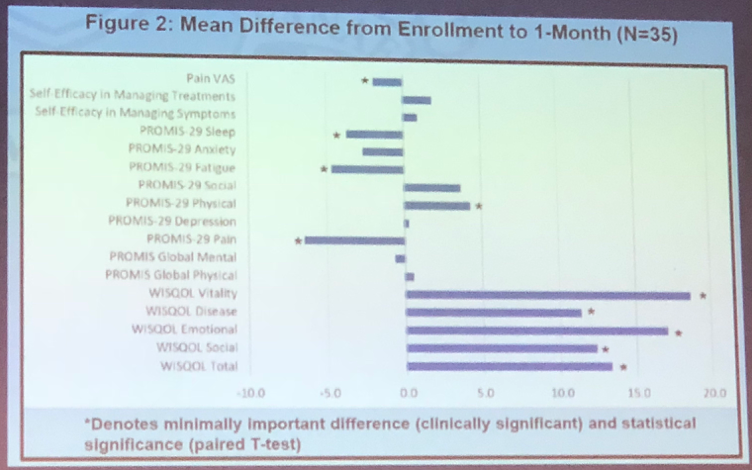Dr. Ziemba and his group at the University of Pennsylvania, focused on characterizing patients with nephrolithiasis and their related HRQOL. Nephrolithiasis is a unique disease due to the wide spectrum of disease activity. To be sure, Dr. Ziemba emphasized during his moderated session, that by following stone formers, it would allow them to uncover and characterize HRQOL and identify trends over time within selected individuals and between individuals with disease activities along the wide spectrum.
Dr. Ziemba conducted a prospective, longitudinal cohort study to identify these trends in HRQOL. He presented the interim data for the cohort with data forms completed at presentation and at 1 month follow-up. Various validated instruments were completed electronically by the enrolled patients including demographics data, WISQOL (disease-specific), various PROMIS (generic/all disease states), and EuroQoL. 113 patients were screened for participation and 69 met inclusion criteria and were elected to participate. 35 of them completed the 1 month battery and 13 subjects had their 1 month battery date approaching. 21 subjects did not complete the 1 month battery.
At the presentation, there was increased PROMIS self-efficacy for managing treatments and symptoms, PROMIS-29 pain intensity, pain interference, anxiety, and social roles and functioning. There was also decreased PROMIS-29 depression.1 month after treatment, there was decreased PROMIS-29 pain intensity, pain interference, sleep disturbance, and fatigue. Moreover, there was increased PROMIS-29 physical function, WISQOL Vitality, emotion, social function, disease and total score. Some of the other mean differences are shown in the graph below.

One limitation that Dr. Ziemba brought up during his presentation was the fact that many older patients were excluded from the study due to the fact that they could not use or had no access to computers. This may indicate a less durable response and that the study demographics may reflect the opinions of younger patients. Nevertheless, Dr. Ziemba concluded that patients clearly are affected in dimensions of pain, anxiety, fatigue, and physical health. From his initial survey data, there are suggestions that treatment may improve many if not all of dimensions.
Presented by: Dr. Justin Ziemba - University of Pennsylvania
Authors: Justin Ziemba, Hanna Stambakio, George Lin, Ian Berger, Ruchika Taiwar, Gregory Tasian, Thomas Guzzo - University of Pennsylvania
Written by: John Sung, Department of Urology, University of California-Irvine, medical writer for UroToday.com. at the 36th World Congress of Endourology (WCE) and SWL - September 20-23, 2018 Paris, France


